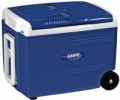Volume
The volume of the working chamber of the car refrigerator. The larger the volume, the more products can be loaded into the unit at a time. When choosing according to this parameter, it makes sense to select a model with a margin, because it is not recommended to load products too tightly — this adversely affects the quality of the device. On the other hand, note that the volumetric container and dimensions will have the appropriate ones.
Operation mode
—
Cooling. A mode of operation in which the food placed inside is cooled to a temperature just above zero (the minimum threshold is usually around 4 °C). Present in all car refrigerators by definition.
—
Freeze. An operating mode designed to cool the food placed in the cooking chamber to a temperature below zero (in some models down to -18°C). In some models, it can also be used for making ice in special compartments.
—
Heating. The mode of operation for heating products is especially useful in the cold season. Many models with this function have fairly good heating characteristics, allowing you to heat food in them to a hot state. This mode is also good for keeping food hot. However, car refrigerators with a heating function are usually quite expensive.
Max. cooling at
This parameter determines how many degrees the refrigerator is able to cool the product loaded into it relative to the ambient temperature. Let's say the maximum cooling for a particular refrigerator model is 20°C; at an air temperature of +30°C, a product with the same temperature is loaded into it. Thus, the final temperature of the product will be 30 – 20 = +10 °C. In addition, it should be noted that the final temperature cannot be lower than the minimum cooling temperature (see Minimum cooling temperature)
Max. heating at
An indicator of how many degrees the refrigerator is able to heat the product placed in it relative to the ambient temperature (if there is a heating function). Suppose a product at a temperature of +15 °C is placed in a refrigerator with a maximum heating of 60 °C; thus, the temperature of the product at the end of heating will be 75 °C, which is more than enough for the perception of food as warm and its comfortable consumption.
Сooling energy consumption
The power consumed by the refrigerator when operating in cooling mode. The greater this power, the more performant the refrigerator is, usually, and the less time it takes to cool the product. On the other hand, note that more power means more power consumption — which can be critical, for example, during long-term operation from a car battery (that is, when the car engine is turned off).
Heating energy consumption
The power consumed by the refrigerator when operating in heating mode. As with cooling, more power usually means more performance; see "'Сooling energy consumption" for details.
Supply voltage
The supply voltage for which the car refrigerator is designed. There are several standard options:
—
12 V Standard voltage of the on-board mains of passenger cars, as well as many minibuses and light trucks. Supported by most modern car refrigerators.
—
24 V Standard voltage of the on-board mains of buses, heavy trucks and other large equipment; also found in some SUVs. Car refrigerators "only for 24 V" are almost never produced; as a rule, this option is provided in addition to 12 V.
—
230 V Powered by a standard household outlet. Usually a backup option, in case the refrigerator needs to be turned on outside the car for a while — for example, to pre-cool before a trip. In addition, units with such power can be used as an improvised replacement for a stationary refrigerator — for example, when going to the country, where there is no permanent refrigerator.

